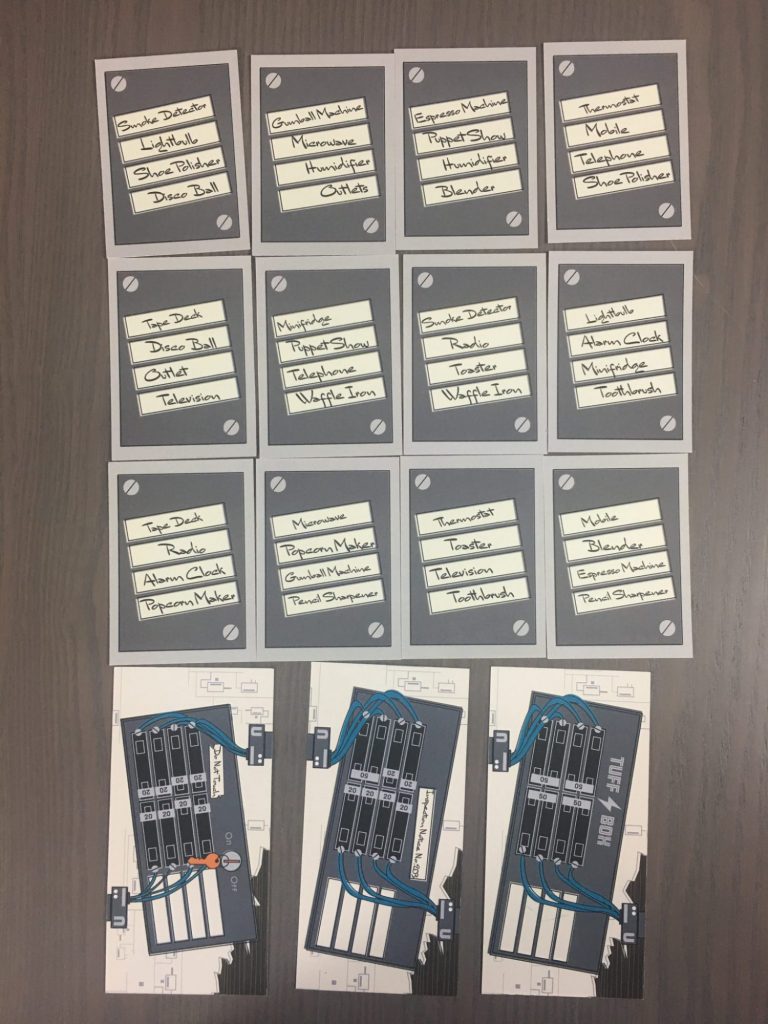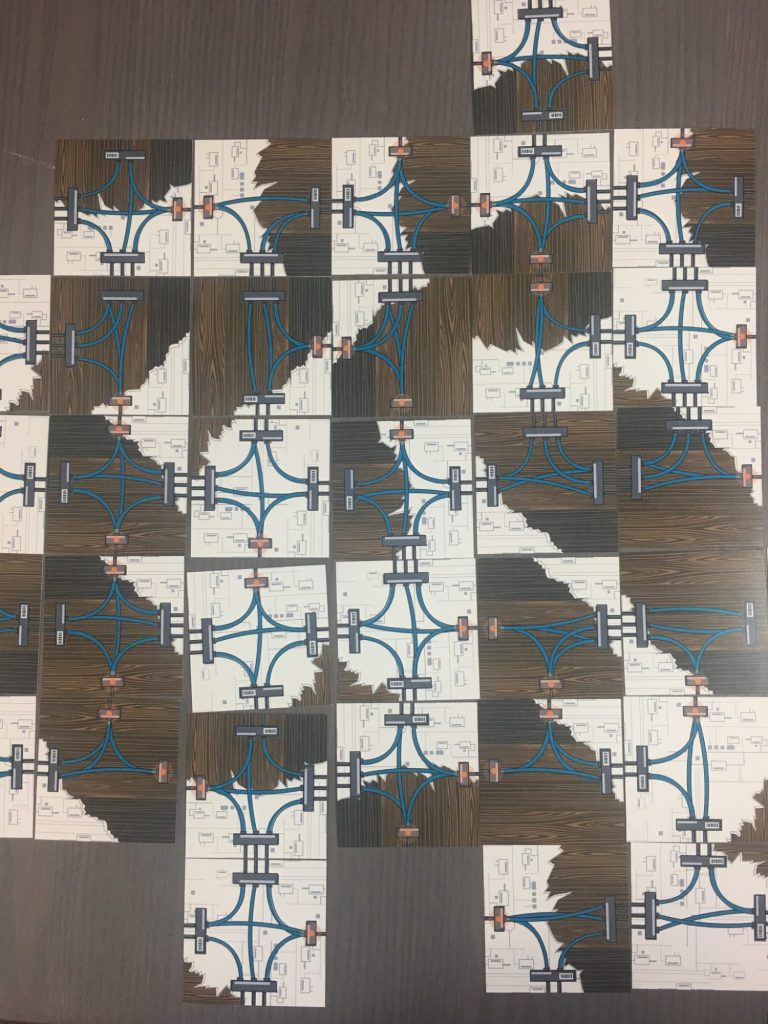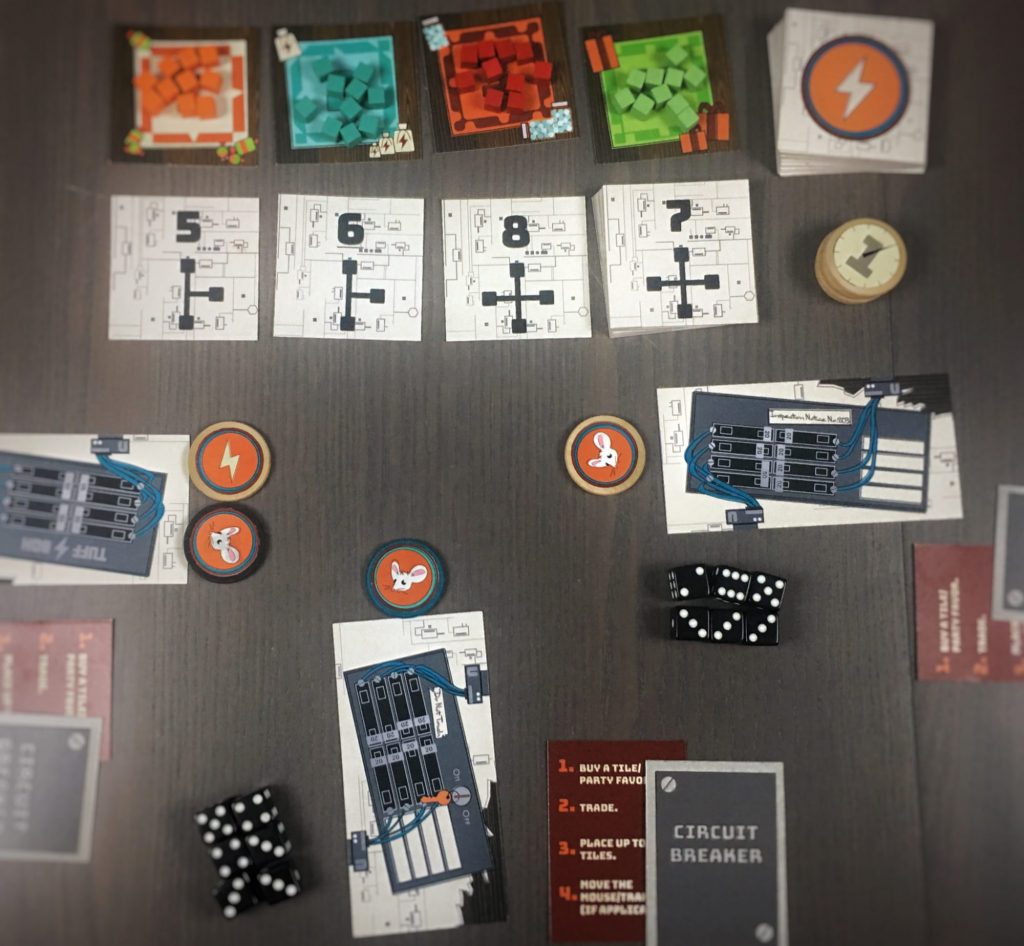Disclosure: Meeple Mountain received a free copy of this product in exchange for an honest, unbiased review. This review is not intended to be an endorsement.
Outpuzzle your friends, or yourself, in this quirkily-themed strategy game.
You’re gonna throw the most rad get together. Party favors, check. Fun electric doodads, check. Wait, your home circuit can’t support it all! You start purchasing wiring and hastily running electrical; picking up more sweet stuff for the party along the way. Unfortunately, it looks like your neighbors are doing the same, obviously trying to steal your party guests. Good thing you’ve befriended a circuit-chomping mouse to sabotage them! Oh no, they have furry companions too!
Overview
Circuit Breaker is a quirky circuit-tile placement game for 1-3 players in which you compete to prepare the best hastily scheduled house party on the block. Taking place over four rounds, players use their dice as the currency in the game. Players will work to quickly build their electric network, add sets of appliances to the network based on their secret objective, and try to sabotage their opponent’s plans.
Gameplay
To set up, each player starts with a mouse tile of a unique color, a circuit breaker card, six dice, a secret objective, three appliance cards, and one wire circuit tile. The party favors are set within reach of all players, a starting player is selected, and play begins. Each of the four rounds begins with all players rolling their dice. On each player’s turn, they have four possible actions, all of which can be completed once, in any order.
- Purchase: a player can purchase one of the three available wire tiles or a party favor. Party favors cost one to four based on color (orange-1, blue-2, red-3, green-4). Items are purchased using one or more of the dice in a player’s dice pool with pips adding up to the cost, exactly.
- Move the mouse/trap (if applicable): The mouse adds a mild take-that element to the game. When making a purchase, a player may increase the cost by two pips to move their mouse/trap to a tile; either in an opponents tableau or onto the appliance draw pile. The mouse doesn’t trigger an effect until it leaves the tile it was placed on during a subsequent round. If the mouse leaves a tile in another player’s tableau, the player controlling the mouse steals the tile. When the mouse leaves the appliance draw pile, the controlling player draws an appliance card. Finally, if someone has placed a mouse in your circuit tableau, you may put your mouse (trap side) onto the same place to move the opponent’s mouse back to the appliance draw pile; keeping your card safe from sabotage.
- Placement: a player may place up to two tiles from their hand into their tableau, making sure that the connections match on all sides.
- Trade: a player may discard an appliance card from their hand to draw the top card from the appliance stack.
At the end of a player’s turn, they must discard down to 5 cards.
Play continues around the table until no players are able to complete at least two actions on their turn at which point the round ends. The player to the left of the current starting player becomes the new starting player, each player draws an appliance card, and all players re-roll the dice to begin the next round. The game ends immediately after the fourth round.

The game has three scoring rubrics. First, a player’s party favor value is added and halved (rounded down), each favor’s value being its cost based on color. Secondly, a player gets three points for each appliance in their circuit that was on their secret objective card, or nine points if they got both copies of that appliance. Finally all other appliances in a player’s circuit score one point. The winner is the player with the most points.

What I Like About Circuit Breaker
The theme of this game is quirky and original, and it drew me in. I love the idea of a neighborhood race to throw the best hastily scheduled house party. I like the ridiculous concept of racing to wire in fun appliances, and it all comes together with the outlandish idea of a mouse you can send to ruin your neighbor’s efforts. The art is fun, and building your electric circuit brings a lot of satisfaction. I really enjoy the puzzle aspect of the circuit building.

The player interaction of the game with 2-3 players hits a sweet spot for me. It has a take-that feel, but because the effect of the mouse is delayed by a round, all players have a chance to react. This one-turn delay can lead to some interesting decisions. Should you spend the extra two pips to move the mouse and prevent a card loss? With this aspect I worried about a lack of dice mitigation, however, with the cost of the cheapest party favor set at one pip, a player will never be in a position in which they have useless dice, and a reaction is almost always possible. There is a risk of your hand being forced which makes you focus on the timing of your actions. For me though, the game shines in the single-player game.
In the solo version of the game, the puzzling out aspect of the game is intensified. The mouse moves from the appliance draw pile, which nets you a card but must move onto an appliance already placed in your circuit. When the mouse leaves that appliance tile back to the draw pile, you must move the appliance back into your hand. This strengthens the dimensions of timing and hand management, which really makes the game hum.
What I Dislike About Circuit Breaker
I have two things that bother me in Circuit Breaker. The first is based on the theme. As I mentioned earlier, I love the quirky theme. I was all in on it, suspending my reality to follow Peter Mariutto into this strange neighborhood in the off-the-wall world he has created. However, the theme stopped short just as I gave it legs. I imagine hurriedly running circuitry in my home to prepare for a party, connecting strange electric doodads I believe will impress my party guests. But then as I look at my secret objective and begin to collect appliance cards, they are, for the most part, not wacky electric party items. Lightbulbs, outlets, electric toothbrushes, microwaves, telephones, alarm clocks; these are a few of the ordinary things that appear in the stack. The only two appliances that really caught my eye as fitting the story set up by the game are the disco ball and electric puppet show. In my opinion, this is a tremendous missed opportunity and one which significantly removes a lot of the game’s excitement.
 The second is more minor. In the version of the game I am reviewing, the circuit wire and appliance tiles are rather large. For a small box game, it consumes a lot of table space. In my opinion, the size of the tiles adds relatively little in the way of displaying the art. Most of the tile space, particularly on the wire tiles, is “white space.” Marriuto has done an excellent job of adding interest to the negative space through his background art. However, I believe the upside of smaller tiles and a smaller gameplay footprint would greatly outweigh the current prominence (or potentially even presence) of this background art.
The second is more minor. In the version of the game I am reviewing, the circuit wire and appliance tiles are rather large. For a small box game, it consumes a lot of table space. In my opinion, the size of the tiles adds relatively little in the way of displaying the art. Most of the tile space, particularly on the wire tiles, is “white space.” Marriuto has done an excellent job of adding interest to the negative space through his background art. However, I believe the upside of smaller tiles and a smaller gameplay footprint would greatly outweigh the current prominence (or potentially even presence) of this background art.
Final Thoughts
The game is fun. As I mentioned earlier, I think the game really shines in its solo player mode. I travel a lot with my work, and I could see this game being a standard tag-along on my trips if only the game footprint weren’t so large. I’ve really enjoyed playing the game solo and sharing it with friends. Freshwater Game Company is bringing Circuit Breaker to Kickstarter, launching on Tuesday, June 5th. I’ll be paying close attention to it. If you enjoy tile-laying games, fun, quirky themes, or light take-that, you should as well. If you like all three, you should back Circuit Breaker today!
Disclaimer: Freshwater Game Company provided Meeple Mountain a preview, prototype version of the game. It is the copy of the game this article is based upon. As such, this article is not necessarily representative of the final product. All photographs, components, and rules described herein are subject to change.












Add Comment